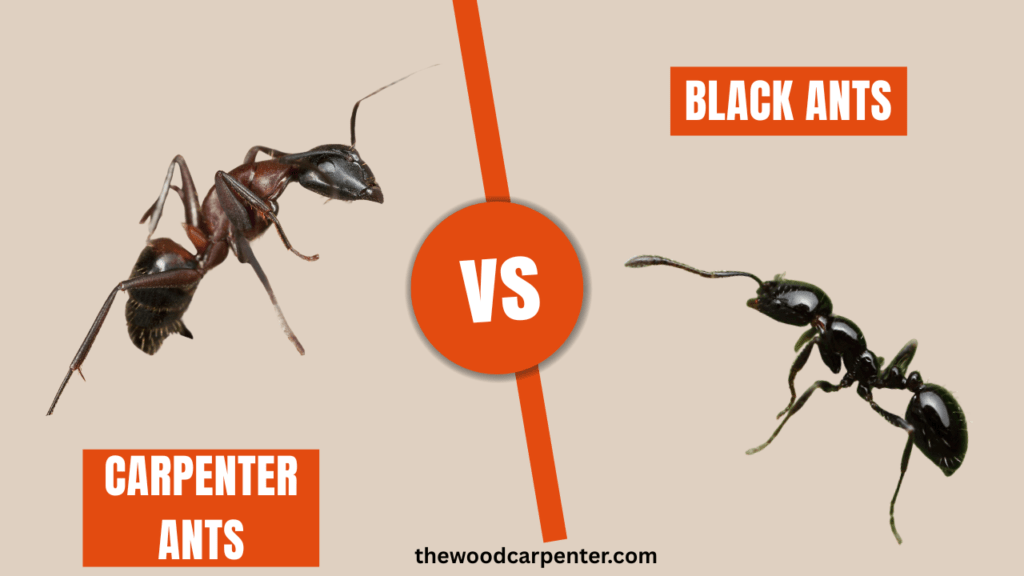
Ants are common pests in many homes, but not all ants are the same. Two types that people often confuse are black ants and carpenter ants. They might look alike at first, but there are important differences between them, especially when it comes to protecting your home from damage.
In this article, we’ll explain the key differences between black ants and carpenter ants, how to tell them apart, and what to do if you find them in your home.
What Are Black Ants ?
“Black ant” is a general term often used to describe several small, dark-colored ant species. The most common type found in homes is the Odorous House Ant (Tapinoma sessile).
Key Characteristics:
Size: Small, around 1/16 to 1/8 inch long (2.5–3 mm)
Color: Dark brown to black
Smell: Emit a rotten coconut-like odor when crushed
Habitat: Prefer moist environments, often nest under rocks, logs, or inside walls
Black ants typically enter homes in search of food and are especially attracted to sweet items like sugar, syrup, or crumbs.
What Are Carpenter Ants ?
Carpenter ants (Camponotus species) are large ants known for nesting in wood. While they don’t eat wood like termites, they tunnel through it to build their nests, which can cause serious structural damage over time.
Key Characteristics:
Size: Much larger, 1/4 to 1/2 inch long (6–12 mm)
Color: Usually black, but can also be red or a mix of both
Body Shape: Uneven, rounded thorax when viewed from the side
Habitat: Prefer damp or rotting wood, often found in walls, decks, window frames, or attics
Black Ants vs Carpenter Ants: Side-by-Side Comparison
Feature Black Ants Carpenter Ants
- Size Small (2–3 mm) Large (6–12 mm)
- Color Dark brown to black Black, red, or bicolored
- Nesting Material Soil, under stones, inside walls Wood (especially moist or damaged)
- Wood Damage None Yes – they excavate wood to nest
- Odor Yes – smells like rotten coconut No distinctive smell
- Threat Level Low – mostly a nuisance High – can cause structural damage
Why the Difference Matters
While black ants are annoying, they don’t pose a serious threat to your home. Carpenter ants, on the other hand, can cause thousands of dollars in structural damage if left untreated. That’s why it’s important to identify which type you’re dealing with.
How to Tell Them Apart
Here are a few simple tips to identify black ants vs carpenter ants:
Look at the size – Carpenter ants are significantly larger.
Check for sawdust – Carpenter ants leave behind “frass” (wood shavings) near their nesting sites.
Listen for rustling – In quiet rooms, carpenter ants can be heard moving inside walls.
Observe their trail – Black ants form large, consistent lines leading to food sources.
Also read:
Carpenter Ants vs Termites: Which One’s Worse?
How to Get Rid of Black Ants
- Clean up food crumbs and spills
- Seal entry points (windows, cracks, doors)
- Use ant bait traps near entryways
- Spray vinegar or soapy water where you see trails
- Maintain a dry and clean home to discourage nesting
How to Get Rid of Carpenter Ants
- Identify and remove damp wood or water-damaged areas
- Set out gel bait or professional-grade ant bait
- Use boric acid in cracks or nest sites (with caution)
- Call a pest control expert for large infestations or recurring problems.
Preventing Ant Infestations
- Whether you’re dealing with black ants or carpenter ants, prevention is key:
- Store food in airtight containers
- Fix water leaks and reduce moisture
- Trim trees and shrubs away from your home’s foundation
- Keep firewood and debris away from the house
Final Thoughts
Understanding the difference between the black ants and carpenter ants is more than just knowing only their names. It can mean the difference between a minor nuisance and a serious home repair bill.
If you’re dealing with ant problems in your home, start by identifying which type you’re seeing. Then take action quickly—especially if carpenter ants are involved.
FAQ’s:
1. What is the main difference between black ants and carpenter ants?
The main difference is that carpenter ants build nests in wood, while black ants nest in soil or under rocks. Carpenter ants can damage wood, while black ants typically don’t.
2. Are carpenter ants dangerous to my home?
Yes, carpenter ants can be harmful because they hollow out wood to build nests. Over time, this can weaken the structure of your home.
3. Do black ants cause any damage ?
No, black ants do not cause damage to wood or structures. They mainly forage for food and may become a nuisance indoors.
4. How can I prevent carpenter ants from entering my home ?
To prevent carpenter ants, seal cracks and gaps around windows and doors, remove excess moisture, and keep wood piles or tree branches away from the house.
5. What should I do if I find carpenter ants in my home?
If you find carpenter ants, it’s important to locate their nest and treat it. You may need to contact a pest control professional to safely remove the ants and prevent further damage.
6. Are black ants attracted to food?
Yes, black ants are attracted to food sources, especially sugary or greasy substances. Keeping food sealed and cleaning up crumbs can help prevent them.
7. Can I treat carpenter ants myself?
Yes, you can treat carpenter ants with over-the-counter insecticides, but if the infestation is large, it’s best to consult a professional for safe and effective removal.
8. Do carpenter ants live inside the wood or just near it?
Carpenter ants build nests inside wood but do not eat the wood. They create galleries in the wood by chewing it and removing the debris.
9. Can I prevent black ants from entering my home?
To prevent black ants, keep food tightly sealed, clean up crumbs, and seal entry points like cracks in walls, windows, and doors.

